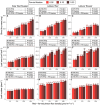Plant Morphology and a Phytochrome B Model Reveal That the Effects of Far-Red Light on Shade-Avoidance-Like Responses Persist Under High Light Intensity
- PMID: 40243773
- PMCID: PMC12223715
- DOI: 10.1111/pce.15562
Plant Morphology and a Phytochrome B Model Reveal That the Effects of Far-Red Light on Shade-Avoidance-Like Responses Persist Under High Light Intensity
Abstract
Several studies have concluded that high photon flux density (PFD) attenuates the effects of the red (R; 600-699 nm) to far-red (FR; 700-750 nm) light ratio on morphology. However, the suppressive effects can depend on individual wavebands that modulate photoreceptor activity. We postulated that morphological responses of shade-avoiding plants to the FR fraction (FR-PFD divided by R + FR PFD) act independent of total PFD (TPFD; 400-750 nm) when TPFD increases are only from R and FR light. We grew kale and lettuce under three FR fractions and four TPFDs while maintaining a constant blue (B; 400-499 nm) PFD. An increase in the R + FR PFD reduced leaf elongation and specific leaf area (SLA). However, higher light did not suppress the FR-fraction effects on leaf elongation and SLA. We estimated PHYB activity with a three-state PHYB model to mechanistically explain the suppressive effects of high light on leaf elongation and SLA but not on FR-mediated leaf elongation and SLA increase. PHYB model predictions were in accordance with the morphological responses of kale and lettuce. This study is the first to apply the three-state PHYB model to explain photon-spectrum-induced morphology of light-grown whole plants, demonstrating its potential use to crops and for applications.
Keywords: Brassica; Lactuca; acclimation; morphogenesis; phytochrome B; vegetables.
© 2025 The Author(s). Plant, Cell & Environment published by John Wiley & Sons Ltd.
Figures











References
MeSH terms
Substances
LinkOut - more resources
Full Text Sources

